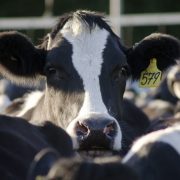To scan or not to scan? The economics of transthoracic ultrasonography for ‘whole-flock’ ovine pulmonary adenocarcinoma screening in UK sheep flocks
To scan or not to scan? The economics of transthoracic ultrasonography for ‘whole-flock’ ovine pulmonary adenocarcinoma screening in UK sheep flocks

Open access
In our edition of: Oct 2022
In our categories of: farm animals
our summary:
Davies, P. et al. (2022) To scan or not to scan? The economics of transthoracic ultrasonography for ‘whole-flock’ ovine pulmonary adenocarcinoma screening in UK sheep flocks. Veterinary Record, 191 (7), p. e1980.
The aim of this study was to simulate the net economic outcome for a commercial flock with a low prevalence of ovine pulmonary adenocarcinoma (OPA) if different culling strategies were adopted based on results obtained from transthoracic ultrasonography (TTUS).
The test performance of TTUS in a low OPA prevalence flock was obtained from a previous study* of 1,074 breeding ewes that underwent TTUS with an experienced operator. Diagnosed OPA cases were assigned a grade. (Grade 0 = no abnormalities detected, Grade 1 = minor abnormality detected but not indicative of OPA, Grade 2 = likely OPA lesions of small to moderate size, Grade 3 = larger, more advanced lesions with the highest supposed likelihood of being OPA). Partial budget analysis was used to test the cost-effectiveness of TTUS as an intervention for three scenarios, (i) where Grade 2 and 3 ewes were culled, (ii) where only Grade 3 ewes were culled and (iii) a scenario in which Grade 2 and 3 ewes were culled but where there was an assumed 100% specificity of TTUS, that is assuming no false positives. A sensitivity analysis was performed to explore the relative influence of model variables.
The analysis showed that the economic impact of culling only the Grade 3 sheep was less costly than culling all Grade 2 and 3 sheep. However, due to the poor clinical performance of TTUS, it was still economically worse for the flock than doing nothing. Where there was an assumed 100% specificity of TTUS, the median economic outcome was still a loss due to the low prevalence of infection in comparison with the high cost of scanning all ewes in the flock.
The authors conclude that if the farm is experiencing less than 7% ewe mortality due to clinical OPA, there is very high confidence that TTUS would have a negative net economic impact.
Although the paper makes the assumptions on which the calculations were based explicit, a limitation of the study is that the initial data relate to a single flock that was scanned by a single clinician, and changes in the economic value of ewes (both cull and replacement) could make a significant difference to the calculations.
*Previous study
Davies, P, et al. (2022) To scan or not to scan? Efficacy of transthoracic ultrasonography for ovine pulmonary adenocarcinoma screening in a large commercial UK sheep flock. Veterinary Record; p. e1578. https://doi.org/10.1002/vetr.1578
This study highlights that in low OPA prevalence flocks, the savings achieved in identifying ewes for culling do not compensate for the high cost of scanning the entire flock.
Claiming CPD for reading inFOCUS articles
Reading and reflecting on articles can count towards your CPD, and we have a template to help you with the process.
Image copyright attribute: photografier
Join the discussion
We encourage discussion on all material highlighted in each edition of inFOCUS. Use the button below to join the conversation on Twitter and include your comment in the feed for this issue.









Leave a Reply
Want to join the discussion?Feel free to contribute!